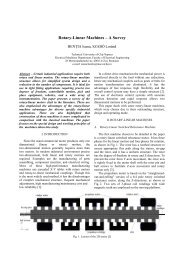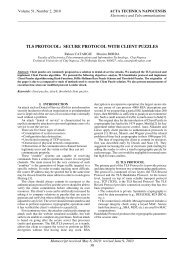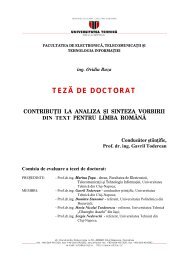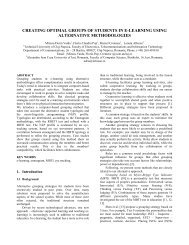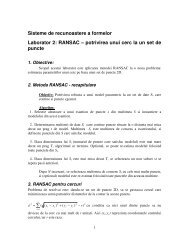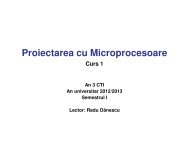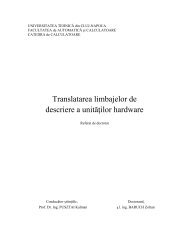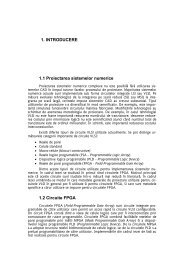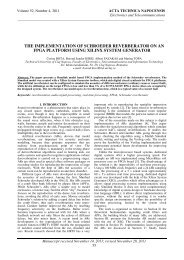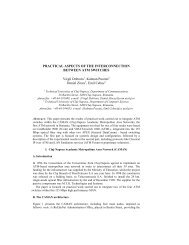LTE Emulator
LTE Emulator
LTE Emulator
Create successful ePaper yourself
Turn your PDF publications into a flip-book with our unique Google optimized e-Paper software.
TUCN – Data Transmission Laboratory<br />
22<br />
2<br />
p = ; 0 r ;<br />
2<br />
σ<br />
(4)<br />
( r)<br />
2<br />
⎧ r ⎛ r ⎞<br />
⎪ ⋅ exp 2<br />
2<br />
σ ⎜<br />
⎜−<br />
⎪ 2 σ ⎟<br />
⎝ ⋅ ⎠<br />
⎪<br />
⎨ ≤ ≤ ∞<br />
⎪0<br />
; r < 0<br />
⎪<br />
⎪<br />
⎩<br />
To calculate the global instantaneous signal to noise ration at a given moment the following<br />
procedure is us:<br />
o the amplitude of the first propagation path (the main path) is considered to equal 1 and<br />
(ai, τi) are the attenuations (expressed as ratios) and the relative delays of the other<br />
multiple propagation paths;<br />
o the amplitudes of the secondary propagation paths will be ai, and the phases of these<br />
paths, relative to the one of the first path are given by:<br />
i<br />
i<br />
r<br />
2<br />
=<br />
φ = 2 π ⋅ f ⋅τ<br />
(5)<br />
where f is the signal frequency; (5) considers only one spectral component, the channel<br />
model being applied separately to each spectral component;<br />
Note: for a single carrier narrow-band transmission, a flat fading in the signal<br />
frequency band should be considered since the amplitude variation of the carrier is<br />
quasi-identical to the variations of the other spectral components of the modulated<br />
signal. For a multi-carrier transmission (OFDM), the global fading which affects<br />
the signal with multipath propagation and implicitly the instantaneous value of the<br />
SNR, have to be computed for each sub-carrier or for each chunk, if the sub-carriers<br />
are grouped.<br />
o The global fading which affects the signal with multipath propagation, i.e. the amplitude<br />
variation of this signal is computed with the following algorithm:<br />
r<br />
g _ cos<br />
r<br />
g _ sin<br />
r<br />
g<br />
=<br />
= f<br />
=<br />
r<br />
N<br />
a<br />
∑<br />
i=<br />
1<br />
2<br />
g _ cos<br />
2<br />
( 1 2)<br />
+ ∑ f a ( ai<br />
2)<br />
⋅ ai<br />
⋅ cos(<br />
φi<br />
)<br />
f<br />
a<br />
i=<br />
1<br />
2 ( a 2)<br />
⋅ a ⋅sin(<br />
φ )<br />
i<br />
+ r<br />
N<br />
2<br />
g _ sin<br />
where rg is the amplitude of the signal affected by the multipath propagation and fast<br />
fading, and fa(p) is the value of the Rayleigh fading corresponding to a signal with power<br />
level p;<br />
o The total instantaneous SNR of the main user, SNRp, and those of the secondary users,<br />
SNRs_i, are given by the following relations:<br />
SNR<br />
SNR<br />
p<br />
s _ i<br />
= SNR<br />
p _ 0<br />
= SNR<br />
p _ 0<br />
+ 20⋅<br />
log<br />
i<br />
10<br />
+ 20⋅<br />
log<br />
i<br />
( rg<br />
0 )<br />
( r ⋅ a )<br />
where rg0 is the signal level of the main user, SNRp_0 is the signal to noise ratio of the<br />
first propagation paths of the main user, rgs_i is the signal level of the secondary user i,<br />
as_i is the attenuation associated to secondary user i (see chapter 5.), SNRp is the<br />
instantaneous total signal to noise ratio of the main user, and SNRs_i is the instantaneous<br />
total signal to noise ratio of the secondary user i; the total SNR considers all the multiple<br />
propagation paths;<br />
10<br />
gs _ i<br />
s _ i<br />
(6)<br />
(7)



